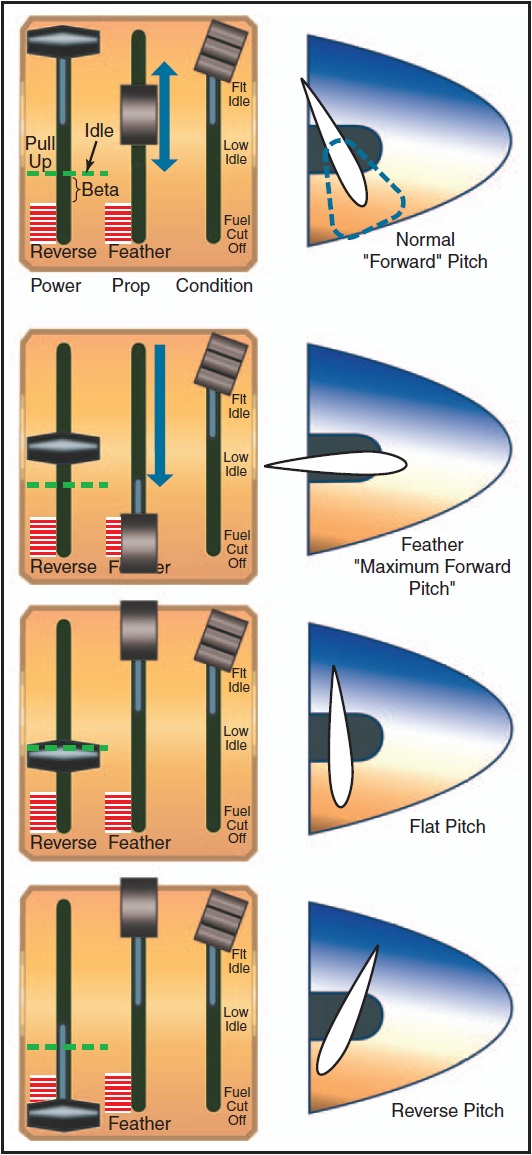
Chapter 14—Transition to Turbopropeller Powered Airplanes
Table of Contents
General
The Gas Turbine Engine
Turboprop Engines
Turboprop Engine Types
Fixed Shaft
Split-Shaft / Free Turbine Engine
Reverse Thrust and Beta Range Operations
Turboprop Airplane Electrical Systems
Operational Considerations
Training Considerations

REVERSE THRUST AND BETA RANGE OPERATIONS
The thrust that a propeller provides is a function of the angle of attack at which the air strikes the blades, and the speed at which this occurs. The angle of attack varies with the pitch angle of the propeller.
So called “flat pitch” is the blade position offering minimum resistance to rotation and no net thrust for moving the airplane. Forward pitch produces forward thrust—higher pitch angles being required at higher airplane speeds.
The “feathered” position is the highest pitch angle obtainable. [Figure 14-8] The feathered position produces no forward thrust. The propeller is generally placed in feather only in case of in-flight engine failure to minimize drag and prevent the air from using the propeller as a turbine.

Figure 14-8. Propeller pitch angle characteristics.
In the "reverse" pitch position, the engine/propeller turns in the same direction as in the normal (forward) pitch position, but the propeller blade angle is positioned to the other side of flat pitch. [Figure 14-8] In reverse pitch, air is pushed away from the airplane rather than being drawn over it. Reverse pitch results in braking action, rather than forward thrust of the airplane. It is used for backing away from obstacles when taxiing, controlling taxi speed, or to aid in bringing the airplane to a stop during the landing roll. Reverse pitch does not mean reverse rotation of the engine. The engine delivers power just the same, no matter which side of flat pitch the propeller blades are positioned.
P>With a turboprop engine, in order to obtain enough power for flight, the power lever is placed somewhere between flight idle (in some engines referred to as “high idle”) and maximum. The power lever directs signals to a fuel control unit to manually select fuel. The propeller governor selects the propeller pitch needed to keep the propeller/engine on speed. This is referred to as the propeller governing or “alpha” mode of operation. When positioned aft of flight idle, however, the power lever directly controls propeller blade angle. This is known as the “beta” range of operation.The beta range of operation consists of power lever positions from flight idle to maximum reverse.
Ch 14.qxd 5/7/04 10:09 AM Page 14-8Beginning at power lever positions just aft of flight idle, propeller blade pitch angles become progressively flatter with aft movement of the power lever until they go beyond maximum flat pitch and into negative pitch, resulting in reverse thrust. While in a fixed shaft/ constant-speed engine, the engine speed remains largely unchanged as the propeller blade angles achieve their negative values. On the split shaft PT-6 engine, as the negative 5° position is reached, further aft movement of the power lever will also result in a progressive increase in engine (N1) r.p.m. until a maximum value of about negative 11° of blade angle and 85 percent N1 are achieved.
Operating in the beta range and/or with reverse thrust requires specific techniques and procedures depending on the particular airplane make and model. There are also specific engine parameters and limitations for operations within this area that must be adhered to. It is essential that a pilot transitioning to turboprop airplanes become knowledgeable and proficient in these areas, which are unique to turbine-enginepowered airplanes.
PED Publication